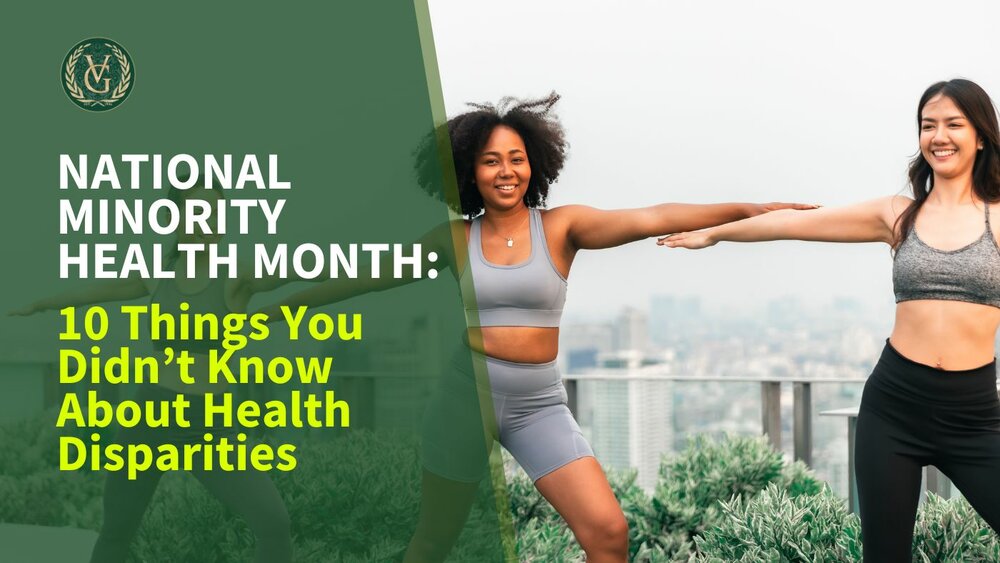National Minority Health Month: 10 Things You Didn’t Know About Health Disparities
April is National Minority Health Month, the perfect time to shed light on the health disparities affecting many communities in the U.S.
While we may be aware of the concept of health equity, understanding the nuances of these differences can deepen our appreciation for the need for change. Here’s a revealing look at ten important facts you might not know about health disparities, along with information designed to inspire and encourage action.
1. What is health equity?
Health equity is all about fairness. It’s when everyone has the opportunity to attain their highest level of health, regardless of their race, background, zip code, or economic status.
2. Health disparities are real.
Health disparities are the differences in health outcomes experienced among different populations. For instance, did you know that African American children are more likely to die from asthma than their non-Hispanic white peers?
3. Language barriers matter.
About 1 in 4 Asian, Native Hawaiian, and Pacific Islander adults report limited English proficiency. This can create significant challenges in navigating the healthcare system, from understanding medical advice to following treatment plans.
4. Access is a major obstacle.
Unequal access to routine health screenings disproportionately affects African American communities. Factors like transportation challenges, lack of health insurance, and health literacy play significant roles in the lack of access.
5. Insurance gaps affect access to care.
Hispanic adults experience the highest rates of uninsured individuals in the U.S. Only 49.9% of Hispanic individuals had private insurance compared to 73.9% of non-Hispanic whites, dramatically reducing their access to necessary health services.
6. Obesity increases the risk of chronic illness,
Hispanics also face unique challenges with higher obesity rates than non-Hispanic whites. This can lead to a cascade of health issues, including diabetes and heart disease.
7. Life expectancy varies significantly by race.
Non-Hispanic Black Americans have a projected life expectancy of just 71.8 years—lower than any other racial or ethnic group in the U.S., highlighting systemic issues that require urgency.
8. Cardiovascular issues are concerning.
African Americans are not only more likely to have cardiovascular disease but also experience higher rates of associated premature death. As of 2024, they were 30% more likely to die from heart disease than white Americans.
9. Screening gaps have consequences.
Asian Americans face alarming rates of liver and stomach cancers, yet they also have the lowest screening rates. By the time they are diagnosed, their cancer is often at a more advanced stage.
10. The stakes are high for native communities.
For American Indians and Alaska Natives, the rate of tuberculosis is ten times higher than that of whites. This group also experiences the highest rates of suicide and unintentional injuries compared to other racial and ethnic populations.
What can you do?
Creating healthier communities starts with awareness and action. Here are a few ways you can make a difference:
- Educate yourself: Understanding these disparities can empower you to advocate for change within your community.
- Know your numbers: Regularly check your blood sugar, blood pressure, and other key health metrics, especially if you're at risk for chronic conditions.
- Screening is vital: Schedule routine screenings like mammograms and colonoscopies. Early detection saves lives.
- Communicate openly: Don’t ignore changes in your health or symptoms. Always consult your healthcare provider and emphasize the importance of effective communication.
During National Minority Health Month, let’s make a collective effort to eliminate health disparities. Together, we can achieve health equity and ensure that everyone has the opportunity for a healthier tomorrow.
Education is key when it comes to understanding and addressing health disparities. Vaughn Greene Funeral Services is proud to offer an array of helpful resources and valuable information. If you have questions or if we can be of assistance, please reach out anytime.
About Vaughn Greene Funeral Services: For more than 25 years, Vaughn Greene Funeral Services has been providing a ministry of care to Baltimore’s African American community. As a leading local, minority- and family-owned provider, we promise to provide our highest level of service and respect to families who entrust us to honor their loved ones. For more information about our funeral, cremation, memorial, repast, and grief counseling services, please call us at 410.655.0015 or visit us online at https://vaughncgreene.com/.











Comments